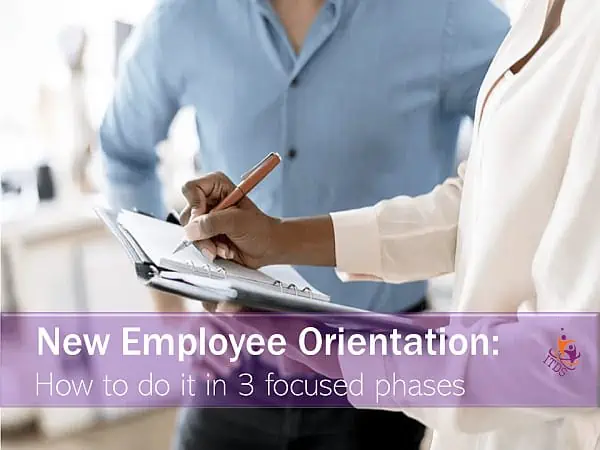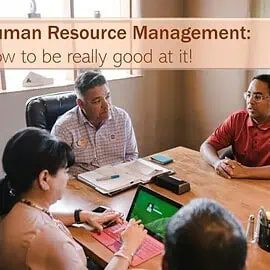Last Updated on April 1, 2024 by Lorna Barrow

“Mummy! You have to come over here and tell these people about new employee orientation, PLEASE!”
I can still remember the agony in my younger son’s voice.
He had turned up at his new vacation job, full of enthusiasm and he had been almost completely ignored.
Many years have passed since my son had that painful experience.
You would think that 20 years or so on, poor or no new employee orientation would be truly a thing of the past.
But no…
Just last week, a frustrated young woman confessed to me that this was her third day on the job and she didn’t know where the bathroom was. And to make matters worse, the business was not that big.
You might be quick to remark that she could have just asked.
But it would have been so much better and professional if someone had shown her where it was, as part of an onboarding process.
Unfortunately, I am intimately familiar with these types of problems. They occur when businesses, especially small businesses, have no new employee orientation plan.
And I really understand why they wouldn’t.
Either they don’t know where to begin or if they do, they don’t have the time to do it or the money to outsource it.
That’s why I want to show you a simple 3-phase process that will make all the difference for your new hires and for your business. And it works if you’re hiring for a junior position or hiring top talent.
But before I do, I want first to look at some of the concerns of both parties as well as remind you of the enormous benefits of an effective onboarding process.
Concerns of the new employee
Most new employee are really happy to have gotten the job. But as the start date draws nearer, they become anxious about a number of things.
For example, they begin asking themselves:
- Will these people like me?
- How hard is this job, really?
- Will I be happy there?
- Was I right to take this job?
- How will I be evaluated?
- Is this really a good business to work for?
If you don’t have a new employee orientation plan, an employee starting a job with these unanswered concerns will take much longer to settle down.
Employer concerns about a new employee orientation plan
On the other hand, the poor employer, especially if she or he is a small business owner, is trying to get the hiring process right. So naturally, you have some questions you really want answered.
These include:
- What should be in any employee orientation plan?
- Who implements it?
- How long should the process take?
- Should we include probation time?
- How soon will this newbie fit in anyhow?
- Is s/he really the right person for this job?
To make matters worse, you’re not sure if you have the people management skills which are equal to the task. So for the time being, you will have to rely on some form of job orientation and hope for the best.
Benefits of having a new employee orientation plan
By now, you must realise that there are significant benefits to helping your new employee feel happy about their new job and their new workplace.
Let me remind you of some of the benefits of having and following a focused, new employee orientation plan:
-
- Provides a professional and positive first impression of your workplace for the new employee
2. Lowers a new employee’s feelings of isolation and anxiety which they often experience at the start of a new job
3. Helps an individual understand the social, technical, and cultural aspects of your new workplace
4. Helps a new hire learn the physical layout of the workplace
5. Provides a chance for both parties to discuss workplace hazards, policies and critical procedures
6. Allows the new employee to clear up any concerns they may have
7. Provides guided support and information in an organized fashion
8. Helps new employees quickly understand what’s expected of them and encourage them to be productive from the very outset
The 3-Phase new employee orientation plan
So we have discussed the concerns of the new employee, the concerns of the employee and the benefits of having a new employee orientation plan as part of your hiring process.
Now you ‘re ready for my favorite orientation plan.
It has 3 phases and it can be used equally by “big business” or small businesses.
You can keep it simple or you can make it more complex. The secret is how well you manage the implementation.
Phase 1: Before the employee arrives
This is an important first step, you should not exclude. Most people think of and start an orientation only when the new employee shows up.
But here are some of the things you can do before the new employee arrives:
- Develop an orientation checklist specific to your business.
2. Make sure that the employee’s supervisor will be at work and available when the new employee shows up.
3. Ensure that all required documents and forms are prepared.
4. Ensure that meaningful work is prepared for the first day.
5. Designate and prepare an appropriate mentor for the new employee.
6. Prepare a package of material for the new employee. You can hand-deliver or mail this to the employee before the employment start date. Some of the key items in this package can include:
-
-
- Any literature on the business
- Organizational chart
- Vision, mission, key policies
- Employee and operations manuals, etc
- Some businesses even include a company T-shirt
-
Pre-arrival orientation is a unique and highly valuable approach in creating a professional, positive first impression for a new employee.
And on top of that, in this highly competitive market, it also reinforces the candidate’s decision to join the business.
Unfortunately, too many businesses are either unaware of this important step or leave it out intentionally.
Phase 2: Job-Site Orientation
This is the part of the new employee orientation plan that most businesses do not pay sufficient attention to.
This occurs during the first day, and focusing on helping the new hire to understand the physical aspect of the workplace.
It includes:
a tour of the workplace, including bathrooms, lunchrooms, etc
introductions to fellow staff members. Be sure to include staff members such as the janitor, etc.
use of key equipment
Evacuation procedures, etc
This phase also gives the employee an opportunity to discus s anything that was not clear in the package they would have received in the pre-orientation package.
For small businesses where there might not be any designated human resources person, the buddy system is effective here.
You can pair a new employee with an experienced or senior employee who will take personal interest in their development and answer any questions.
You can help the “buddy” by preparing a cheat sheet of frequently asked questions.
Phase 3: Job-Specific Orientation
This 3rd phase of the new employee orientation occurs during the first few weeks. It is also the phase in which the new employee and their supervisor works closely together.
They will concentrate on details such as specific duties, budgets, tools, software, health and safety, etc.
Alternatively, it can be divided and delivered in manageable information slices and tied closely to the probation period.
If done right , this phase produces a well-documented paper trail which is useful in future performance management.
During this time, frequent coaching and feedback sessions will ensure that everything is on the right track. Both parties can examine how they are working together.
All in all, the new employee truly benefits from close contact with the immediate supervisor by gaining a clear understanding of established goals, expectations, and responsibilities.
Your next “new employee orientation” step
So there you have it!
A 3-phase new employee orientation plan all laid out for you.
I’ve also addressed your concerns and those of the new hire and I’ve shared some benefits with you.
By now, you know that the benefits of having an orientation process far outweigh the pain and frustration of not having one.
So…what’s your next step?
You’re not going to believe this but you don’t have to wait until you’re ready to hire to implement your plan.
For example, you can begin putting together your phase-1 package right now.
You can also practice and refine it bit by bit with your existing employees.
But best of all, you can decide that your hiring process is NOT complete without it!
To your orientation plan success…



